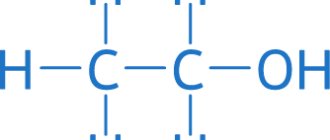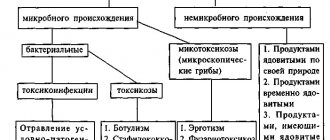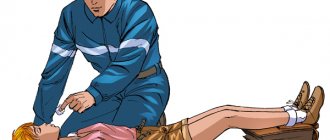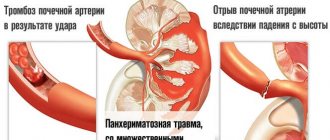Chlorine and chlorine-containing substances are quite often used both in industry and in the domestic sphere. Chlorine is used in the production of various solvents, pesticides, insecticides, medicines, detergents, bleaching and disinfectants. It is also widely used in non-ferrous metallurgy and plastics production. Considering that this substance has become quite firmly established in modern life, it is necessary to know the conditions for using chlorine-containing substances, how to help a person with chlorine poisoning, identify the first signs of such poisoning, and also know preventive measures to avoid unpleasant consequences.
What is chlorine and where is it used?
Chlorine, as a chemical element, belongs to the group of halogens and is present in all living organisms in the form of various compounds. The ions of this substance actively participate in the metabolic processes of the body as water-salt solutions, help reduce the increased activity of neurons, as well as improve the production of gastric juice and hydrochloric acid. For an adult, the daily intake of chlorine is approximately 0.8 grams of the substance, which is replenished by consuming table salt.
Content:
- What is chlorine and where is it used?
- How can you get poisoned by chlorine?
- Symptoms of chlorine poisoning
- First aid for chlorine poisoning
- Possible consequences and prevention of chlorine poisoning
- Finally
Chlorine itself is quite toxic; it is a yellowish-green gas with a metallic taste and a pungent odor. This chemical element is highly soluble in water, as well as in other organic liquids. It is widely used in household and industrial areas.
Chlorine is used to disinfect drinking and waste water, to produce pesticides used to kill rodents and insects, and to bleach fabrics in industrial and household conditions. It is used as one of the components of chemical warfare agents. Chlorine is important in metallurgical production and in the production of plastics. The medical industry actively uses chlorine to create medicines and food additives.
However, its high toxicity has led to the fact that this substance is prohibited for use in a number of European countries. When burned, chlorine forms a very dangerous substance - dioxin, which has immunosuppressive, teratogenic, carcinogenic and embryotoxic effects.
The maximum permissible standards of chlorine in domestic conditions are 0.1 milligrams per cubic meter of air (one-time), in industrial conditions the standards are higher and amount to 1 milligram per cubic meter.
How can you get poisoned by chlorine?
Most often, poisoning with chlorine and chlorine-containing substances is possible in the following situations:
- when inhaling gaseous substances;
- when ingesting pesticides or liquids containing chlorine by accident or in an attempt to commit suicide;
- in case of violation of safety regulations when working with toxic substances at industrial enterprises or at home;
- when visiting a public swimming pool, where there is no proper control over the use and dosage of disinfectants;
- when an aqueous solution of chlorine in high concentrations comes into contact with the mucous membranes or skin, especially in children;
Poisoning and contact with toxic substances, in particular chlorine-containing compounds, are especially dangerous for young children. A much smaller dose of the toxin can cause intoxication in a child compared to an adult and lead to irreparable consequences.
The dangers of bleach
Bleaching lime belongs to the class of highly hazardous substances (class 2).
It is a caustic compound that can cause chemical burns if it comes into contact with eyes or skin, and can cause corrosion of materials and equipment. Ingestion of the substance is extremely dangerous. The reagent releases toxic chlorine, causing poisoning and even death. When heated, flammable oxygen is also released. In addition, bleach can cause ignition of flammable substances and intensify their combustion.
Symptoms of chlorine poisoning
Manifestations of intoxication depend on the route of entry of poison into the body: through the respiratory system (inhalation); through the digestive tract (when taken orally); through the skin; as well as the amount and time of exposure to a person.
There are three degrees of severity of poisoning with chlorine and chlorine-containing substances: mild, moderate and severe. At very high concentrations of poison, poisoning occurs instantly.
Manifestations of mild chlorine poisoning are characterized by:
- moderate headache, dizziness.
Symptoms when poison enters through the upper respiratory tract:
- sore throat and nasopharynx;
- excessive lacrimation and rhinorrhea;
- redness of the eyes and mucous membranes of the mouth;
- burning and pain in the eyes;
- dry cough, frequent sneezing.
Symptoms when poison enters the gastrointestinal tract:
- pain, cramping in the abdomen;
- nausea, vomiting;
- loose stool.
If poison gets on the skin and mucous membranes:
- rash, itching and burning;
- contact dermatitis.
In moderate and severe forms of poisoning with chlorine and chlorine-containing substances, the symptoms of intoxication are more intense:
- hoarseness of voice, feeling of lack of air;
- unproductive shallow breathing, shortness of breath, up to suffocation, respiratory arrest;
- dry painful cough, turning into a wet cough with pink foamy discharge;
- acute pain in the chest area, significantly aggravated by coughing;
- nausea and repeated vomiting;
- decreased blood pressure and decreased heart rate;
- convulsive syndrome;
Chlorine poisoning may initially resemble a state of intoxication, then drowsiness, turning into impaired consciousness, even coma, depending on the amount of poison entering the body. This condition can last approximately three to four days, and at best ends with recovery from a coma with possible serious complications, damage to the liver, kidneys, and lungs.
In a fulminant course, all symptoms manifest themselves in an extremely severe form in the shortest period of time: suddenly developing suffocation with pulmonary edema, possible convulsive syndrome, cardiac arrhythmia, leading to cessation of breathing and cardiac activity.
Clinical picture
If poisoned by caustic bleach vapors, the victim will experience:
- headaches;
- sharp painful cough due to sore throat and nasopharynx;
- dry mouth;
- redness of the sclera of the eyes, itching;
- a chemical burn of the mucous membranes of the eyes, sometimes leading to partial or complete loss of vision.
If bleach gets on your skin, the affected area will show:
- redness;
- irritation;
- development of dermatitis (in more severe cases).
Penetration of the solution inside threatens particularly severe manifestations:
- instant burn of the mucous membranes of the mouth, throat and all other digestive organs (and just one sip is enough for this);
- severe burning pain (due to bleach corroding the mucous membranes);
- vomiting with blood without relief after an attack (blood in the vomit indicates bleeding of the stomach and intestines due to burns);
- lack of air, suffocation (due to swelling of the throat);
- motor and mental overexcitation;
- sometimes - an increase in temperature;
- urine becomes dark brown due to toxic effects on the kidneys.
Light form
With mild poisoning, a person may experience:
- irritation of the mucous membranes of the mouth and respiratory tract (accompanied by a feeling of “scratching”, soreness);
- sharp cough;
- lacrimation;
- constant smell of chlorine even in clean air.
This stage does not require hospitalization; everything goes away within a few hours after assistance is provided.
Severe form
In case of severe intoxication, the poisoned person loses consciousness and convulsions may begin. Breathing suddenly slows down and may stop altogether. The result is the death of the victim if there is delay in providing assistance and calling a doctor. The patient needs to be treated only in a hospital; there are no other options.
This form is very dangerous because the symptoms of such bleach poisoning increase too quickly. The poisoned person immediately develops convulsions, and swelling of the veins in the neck is observed. Following this, consciousness is lost, breathing stops and death occurs.
It is useless to help the victim at home. Only resuscitation measures can save a person.
Chronic form
Chronic poisoning with chlorine-containing products usually develops in those who often come into contact with this chemical on duty. The first in this risk group are cleaners and repairmen involved in whitewashing with bleach solution. In everyday life, this form can be obtained by housewives who are obsessed with cleanliness and cannot imagine carrying out daily cleaning without using a strong bleach solution for the purpose of total disinfection.
Symptoms in the chronic form are not as pronounced as in other stages, but over time they may appear:
- breathing problems;
- laryngitis;
- irritability;
- persistent cough (even if the person does not smoke);
- sometimes - pneumonia of non-microbial etiology;
- convulsive twitching of the calves.
It is quite difficult to suspect that the deterioration of a person’s condition is connected specifically with bleach, so even when visiting a doctor, people unknowingly keep silent about the fact that they often come into contact with this chemical. Hence, as a rule, false preliminary diagnoses are made. Only a comprehensive examination will help determine exactly what the reason is.
Acute chlorine poisoning is characterized by the sudden onset of symptoms of poisoning and the rapid development of the clinical picture. The difference from chronic poisoning is a single intake of a significant dose. In the second case, people whose activities involve chlorine constantly receive small amounts of the substance.
Acute chlorine poisoning can occur in several forms:
- light;
- average;
- heavy;
- lightning fast.
Characteristics of a mild form of chlorine poisoning: symptoms are mild, treatment is not required. I'm worried about a slight soreness in the mouth and throat, pain in the eyes.
Moderate chlorine poisoning requires assistance and is characterized by a barking, dry cough that is difficult to stop. Choking, lacrimation and chest pain appear. At this stage of chlorine poisoning, a burn of the mucous membrane of the larynx is already detected. After a few hours, pulmonary edema develops. Signs of a disturbance in nervous activity appear: the person becomes inhibited or excited.
If in the conditions of an incident it is not possible to immediately provide medical care, then first aid should be provided immediately.
Chronic chlorine poisoning is fraught with the development of a number of diseases:
- chronic recurrent bronchitis;
- pulmonary tuberculosis;
- tracheitis and tracheobronchitis;
- emphysema;
- cardiopulmonary failure;
- bronchopneumonia;
- dermatitis;
- bronchiectasis.
First aid for chlorine poisoning
First of all, immediately call emergency services and rescuers. The victim must be urgently removed from the affected area, observing safety measures for the rescuer himself, namely: protection of the respiratory system, skin, and mucous membranes from poison entering the body (cotton and gauze bandages, respirators, goggles, gloves, protective clothing). In case of direct contact with a chlorine-containing substance, immediately stop its entry into the body by rinsing the skin with running water.
How you can help a person with chlorine poisoning:
- Unbutton your clothes, open the window, let in fresh air and ventilate the room.
- Rinse your mouth and nasal passages, and thoroughly rinse your eyes with plenty of running water or a two percent solution of baking soda.
- Provide the victim with alkaline drinks, milk, and mineral water.
- You can use soda inhalations.
- Provide the patient with emotional and physical peace.
- If liquids containing chlorine that do not have a corrosive effect are swallowed, with the victim clearly conscious, offer to drink large quantities of water and induce vomiting.
After providing first aid, the patient must be taken to a medical facility for further observation and treatment. The first day the patient should be under the supervision of qualified personnel, this will help to avoid many unpleasant serious consequences and prevent the occurrence of possible serious complications.
When treated in a hospital, therapy is aimed at restoring and maintaining the vital functions of the victim’s body:
- oxygen support if necessary;
- stabilization of breathing and blood circulation;
- normalization of metabolic processes;
- prevention of possible complications from the kidneys, brain, gastrointestinal tract;
- symptomatic therapy.
Possible consequences and prevention of chlorine poisoning
With mild forms of chlorine intoxication, complications are usually absent. Recovery occurs a few days after the toxin enters the body.
After suffering moderate and severe forms of intoxication, the development of acute and chronic conditions is possible:
- respiratory tract diseases: pharyngitis, laryngitis, bronchitis, tracheitis, tracheobronchitis;
- toxic pneumonia and pulmonary edema;
- conjunctivitis;
- acute heart failure;
- bronchiectasis;
- paralysis of the vasomotor and respiratory centers;
- pneumosclerosis and emphysema.
To protect yourself from such consequences and from the possibility of chlorine poisoning, you must follow safety rules when working with hazardous substances at work, as well as at home:
- Work with chlorine-containing substances in well-ventilated areas with sufficient access to fresh air.
- Use personal protective equipment (rubber gloves, respirators, cotton gauze bandages) when working with substances containing chlorine.
- Work with pesticides and insecticides only in safety glasses and a respirator.
- Visit swimming pools in trusted places.
- Store poisons and household chemicals out of the reach of children, with clear labeling.
At recommended doses
Rospotrebnadzor itself recommended using products containing chlorine to disinfect housing in early April. Then the federal department published a list of 12 points.
“Wash with soap or treat with an alcohol-based antiseptic of at least 70% or a chlorine-containing solution. You need to wash those hands that you touch when you come home, before you wash your hands with soap. After cleaning door handles, be sure to wash your hands with soap,” the first paragraph said.
In addition, the department drew attention to the need to treat switches with an antiseptic wipe if a person with coronavirus lives in the room. During cleaning, it was also suggested to wash cabinet handles with soap, wipe the backs of chairs not upholstered with soft material, wipe the surfaces of desks, coffee tables, kitchen countertops and household appliances.
Photo: Depositphotos
It is recommended to additionally treat toiletries, including toothbrushes, with an antiseptic. It was proposed to wash the sink with household chemicals, which were then thoroughly rinsed with water; the bathtub and toilet should be cleaned using chlorine-containing products.
If there is a person with coronavirus infection in the house, it is recommended to repeat the procedure after each use. At the same time, the recommendations emphasize that, first of all, it is recommended to use chlorine-based products in a house where there is a patient. In other cases, regular cleaning using ordinary household chemicals is sufficient.
“We use medical alcohol instead of antiseptic”
Beauty salon owners and craftsmen talk about working during an epidemic








